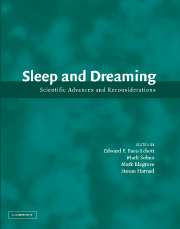Book contents
- Frontmatter
- Contents
- Preface
- Introduction
- 1 Dreaming and the brain: Toward a cognitive neuroscience of conscious states
- 2 Dreaming and REM sleep are controlled by different brain mechanisms
- 3 A review of mentation in REM and NREM sleep: “Covert” REM sleep as a possible reconciliation of two opposing models
- 4 The case against memory consolidation in REM sleep
- 5 The reinterpretation of dreams: An evolutionary hypothesis of the function of dreaming
- Open Peer Commentary and Authors' Responses
- References
- Postscript: Recent findings on the neurobiology of sleep and dreaming
- Index
2 - Dreaming and REM sleep are controlled by different brain mechanisms
Published online by Cambridge University Press: 11 January 2010
- Frontmatter
- Contents
- Preface
- Introduction
- 1 Dreaming and the brain: Toward a cognitive neuroscience of conscious states
- 2 Dreaming and REM sleep are controlled by different brain mechanisms
- 3 A review of mentation in REM and NREM sleep: “Covert” REM sleep as a possible reconciliation of two opposing models
- 4 The case against memory consolidation in REM sleep
- 5 The reinterpretation of dreams: An evolutionary hypothesis of the function of dreaming
- Open Peer Commentary and Authors' Responses
- References
- Postscript: Recent findings on the neurobiology of sleep and dreaming
- Index
Summary
Abstract: The paradigmatic assumption that REM sleep is the physiological equivalent of dreaming is in need of fundamental revision. A mounting body of evidence suggests that dreaming and REM sleep are dissociable states, and that dreaming is controlled by forebrain mechanisms. Recent neuropsychological, radiological, and pharmacological findings suggest that the cholinergic brain stem mechanisms that control the REM state can only generate the psychological phenomena of dreaming through the mediation of a second, probably dopaminergic, forebrain mechanism. The latter mechanism (and thus dreaming itself) can also be activated by a variety of nonREM triggers. Dreaming can be manipulated by dopamine agonists and antagonists with no concomitant change in REM frequency, duration, and density. Dreaming can also be induced by focal forebrain stimulation and by complex partial (forebrain) seizures during nonREM sleep, when the involvement of brainstem REM mechanisms is precluded. Likewise, dreaming is obliterated by focal lesions along a specific (probably dopaminergic) forebrain pathway, and these lesions do not have any appreciable effects on REM frequency, duration, and density. These findings suggest that the forebrain mechanism in question is the final common path to dreaming and that the brainstem oscillator that controls the REM state is just one of the many arousal triggers that can activate this forebrain mechanism. The “REM-on” mechanism (like its various NREM equivalents) therefore stands outside the dream process itself, which is mediated by an independent, forebrain “dream-on” mechanism.
- Type
- Chapter
- Information
- Sleep and DreamingScientific Advances and Reconsiderations, pp. 51 - 58Publisher: Cambridge University PressPrint publication year: 2003
- 21
- Cited by



